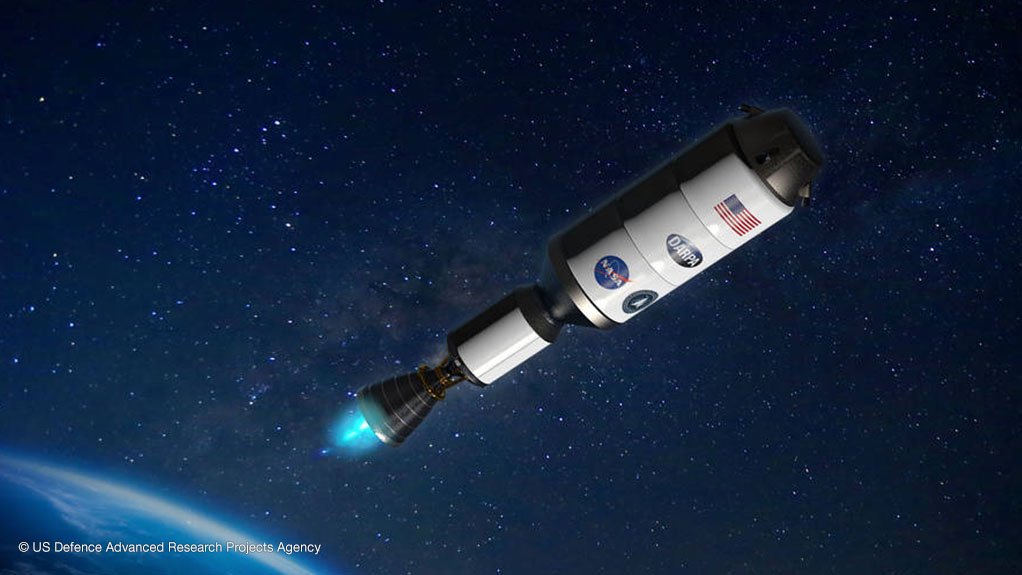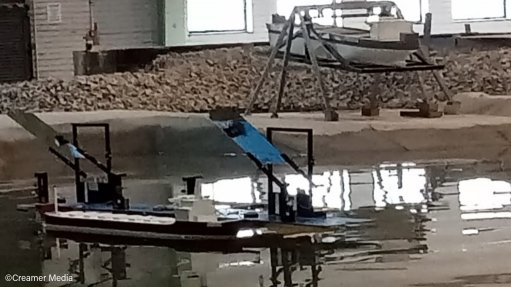Nasa announces nuclear space rocket engine development and test programme


An artist’s impression of the Draco spacecraft in operation
Photo by US Defence Advanced Research Projects Agency
The US National Aeronautics and Space Administration (Nasa) announced on Tuesday that it was collaborating with the US Defence Advanced Research Projects Agency (Darpa) to build and demonstrate in space a nuclear thermal rocket engine. The joint programme is designated the Demonstration Rocket for Agile Cislunar Operations (Draco). This technology, once proven, will be used to propel crewed interplanetary space craft, needed to voyage to and from Mars.
A nuclear thermal rocket engine will use a nuclear fission reactor to produce very high temperatures. This heat will then be transferred to a liquid propellant, which will expand and be exhausted through a nozzle, so driving the spacecraft forward. Nuclear thermal propulsion could have three, or even more, times the efficiency of conventional chemical propulsion. The result will be faster voyages to Mars, reducing the time needed for a mission to the Red Planet and so, for example, resulting in the ship having to carry fewer supplies to sustain its crew. It could also be used to carry heavier cargoes from Earth orbit to the Moon, and back.
“Nasa will work with our long-term partner, Darpa, to develop and demonstrate advanced nuclear thermal propulsion technology as soon as 2027,” highlighted Nasa administrator Bill Nelson. “With the help of this new technology, astronauts could journey to and from deep space faster than ever – a major capability to prepare for crewed missions to Mars.”
The technical development of the nuclear thermal rocket engine will be led by Nasa’s Space Technology Mission Directorate (STMD). Darpa will provide the spacecraft on which the engine will be demonstrated. Darpa will be the contracting authority for the spacecraft, the engine (including the reactor) and be the lead agency for Draco, responsible for rocket systems procurement and integration, safety and liability, assembly of the spacecraft and the integration of the nuclear engine with it. Assembly of the engine itself will be jointly done by Nasa and Darpa.
“The space domain is critical to modern commerce, scientific discovery, and national security,” pointed out Darpa director Dr Stefanie Tompkins. “The ability to accomplish leap-ahead advances in space technology through the Draco nuclear thermal rocket programme will be essential for more efficiently and quickly transporting material to the Moon and, eventually, people to Mars.”
Nasa last examined, and carried out ground tests of, nuclear thermal rocket engines more than 50 years ago. That programme was terminated before any flight tests were carried out.
“With this collaboration, we will leverage our expertise gained from many previous space nuclear power and propulsion projects,” noted Nasa associate administrator for STMD Jim Reuter. “Recent aerospace materials and engineering advancements are enabling a new era for space nuclear technology, and this flight demonstration will be a major achievement toward establishing a space transportation capability for an Earth-Moon economy.”
Nasa is also working with the US Department of Energy (DoE) on other projects to use nuclear power in space. One of these is focused on developing higher temperature fission reactors and fuels for a future generation of nuclear thermal rocket engines, to follow on from the Draco-generation now being developed. Another Nasa/DoE programme has seen three companies awarded contracts to develop micro nuclear power plants that could be used to power lunar, and later Martian, outposts.
Comments
Announcements
What's On
Subscribe to improve your user experience...
Option 1 (equivalent of R125 a month):
Receive a weekly copy of Creamer Media's Engineering News & Mining Weekly magazine
(print copy for those in South Africa and e-magazine for those outside of South Africa)
Receive daily email newsletters
Access to full search results
Access archive of magazine back copies
Access to Projects in Progress
Access to ONE Research Report of your choice in PDF format
Option 2 (equivalent of R375 a month):
All benefits from Option 1
PLUS
Access to Creamer Media's Research Channel Africa for ALL Research Reports, in PDF format, on various industrial and mining sectors
including Electricity; Water; Energy Transition; Hydrogen; Roads, Rail and Ports; Coal; Gold; Platinum; Battery Metals; etc.
Already a subscriber?
Forgotten your password?
Receive weekly copy of Creamer Media's Engineering News & Mining Weekly magazine (print copy for those in South Africa and e-magazine for those outside of South Africa)
➕
Recieve daily email newsletters
➕
Access to full search results
➕
Access archive of magazine back copies
➕
Access to Projects in Progress
➕
Access to ONE Research Report of your choice in PDF format
RESEARCH CHANNEL AFRICA
R4500 (equivalent of R375 a month)
SUBSCRIBEAll benefits from Option 1
➕
Access to Creamer Media's Research Channel Africa for ALL Research Reports on various industrial and mining sectors, in PDF format, including on:
Electricity
➕
Water
➕
Energy Transition
➕
Hydrogen
➕
Roads, Rail and Ports
➕
Coal
➕
Gold
➕
Platinum
➕
Battery Metals
➕
etc.
Receive all benefits from Option 1 or Option 2 delivered to numerous people at your company
➕
Multiple User names and Passwords for simultaneous log-ins
➕
Intranet integration access to all in your organisation



















